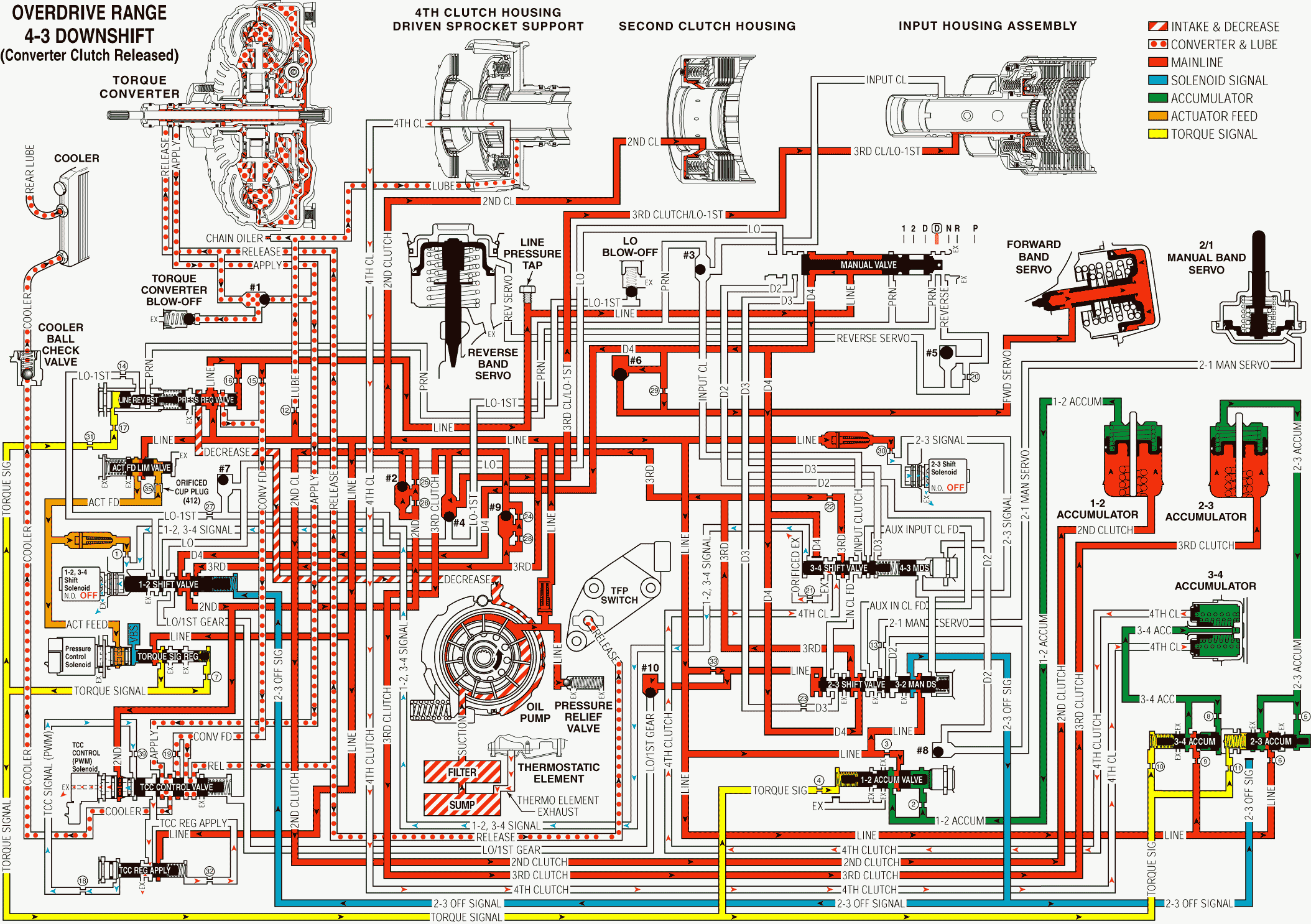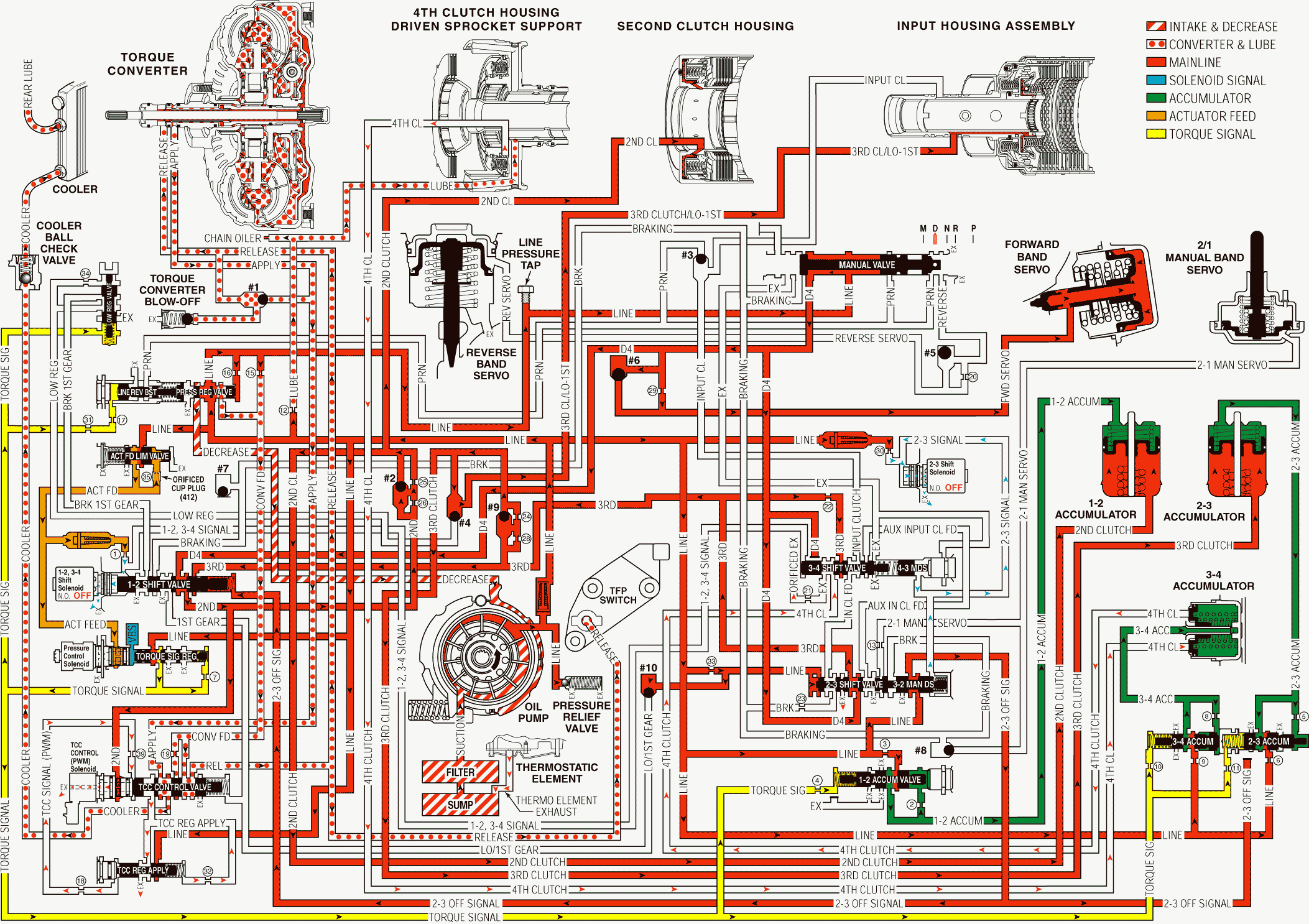Overdrive Range, 4-3 Downshift - Torque Converter Clutch Not Applied Without Touch Activated Power
When the transmission is operating in Fourth gear, a 4-3 downshift will occur if there is a significant change (increase) in the throttle position or if the load on the engine is increased. When the 4-3 downshift occurs, the torque converter clutch will release prior to the shift occurring which results in the following changes in the hydraulic system:
Pressure Control (PC) Solenoid
During the downshift, except for a coastdown, the PCM senses the increase in throttle position or engine load and increases the PC solenoid duty cycle. The increase in duty cycle increases output fluid pressure from the PC solenoid, thereby increasing torque signal fluid pressure at the torque signal regulator valve.
Pressure Regulator Valve
Increased torque signal fluid pressure acting on the line boost valve increases line pressure at the pressure regulator valve.
TCC Control (PWM) Solenoid Valve
As the throttle position changes, the throttle position sensor provides input to the PCM indicating throttle angle. The PCM then lowers the ON/OFF cycle time of the TCC control PWM solenoid valve, lowering TCC signal (PWM) fluid pressure.
TCC Control Valve
Lowered TCC signal (PWM) fluid pressure allows the valve to move with spring pressure, allowing converter feed fluid into the TCC release circuit. TCC release fluid is then routed to the torque converter pressure plate and disengages the torque converter clutch, TCC apply fluid from the torque converter clutch pressure plate is then routed back through its circuit to the converter clutch control valve. TCC apply fluid passes through the valve and enters the cooler circuit.
Transmission Fluid Pressure (TFP) Manual Valve Position Switch
When the TCC is in the release position, TCC release fluid pressure is routed to the TFP manual valve position switch. This fluid pressure signals the PCM that the TCC is in the released position.
1-2, 3-4 Shift Solenoid (SS) Valve (315)
De-energizes, allowing 1-2, 3-4 signal fluid at the 3-4 shift valve (362) to exhaust through the solenoid.
3-4 Shift Valve (362)
When 1-2, 3-4 signal fluid exhausts, spring force moves the valve allowing 4th clutch fluid to exhaust through the valve.
Fourth Clutch
Fourth Clutch fluid is exhausted at the 3-4 shift valve and the driven support ball check valve. Fourth clutch return spring pressure moves the fourth clutch piston and releases the fourth clutch.
3-4 Accumulator
4th Clutch fluid exhausts from the accumulator. Spring force and 3-4 accumulator feed fluid pressure move the accumulator piston to the Third gear position.
3-4 Accumulator Valve
The accumulator valve regulates line pressure into the 3-4 accumulator fluid circuit to fill the 3-4 accumulator. This regulation is basically controlled by torque signal fluid pressure. Increased torque signal fluid pressure regulates accumulator fluid to a higher pressure. Note: The clutch and band application information is the same as Overdrive Range -- Third Gear.
Overdrive Range, 4-3 Downshift - TCC Not Applied - Without Touch Activated Power

Overdrive Range, 4-3 Downshift - Torque Converter Clutch Not Applied With Touch Activated Power
When the transmission is operating in Fourth gear, a 4-3 downshift will occur if there is a significant change (increase) in the throttle position or if the load on the engine is increased. When the 4-3 downshift occurs, the torque converter clutch will release prior to the shift occurring which results in the following changes in the hydraulic system:
Pressure Control (PC) Solenoid
During the downshift, except for a coastdown, the PCM senses the increase in throttle position or engine load and increases the PC solenoid duty cycle. The increase in duty cycle increases output fluid pressure from the PC solenoid, thereby increasing torque signal fluid pressure at the torque signal regulator valve.
Pressure Regulator Valve
Increased torque signal fluid pressure acting on the line boost valve increases line pressure at the pressure regulator valve.
TCC Control (PWM) Solenoid Valve
As the throttle position changes, the throttle position sensor provides input to the PCM indicating throttle angle. The PCM then lowers the ON/OFF cycle time of the TCC control PWM solenoid valve, lowering TCC signal (PWM) fluid pressure.
TCC Control Valve
Lowered TCC signal (PWM) fluid pressure allows the valve to move with spring pressure, allowing converter feed fluid into the TCC release circuit. TCC release fluid is then routed to the torque converter pressure plate and disengages the torque converter clutch, TCC apply fluid from the torque converter clutch pressure plate is then routed back through its circuit to the converter clutch control valve. TCC apply fluid passes through the valve and enters the cooler circuit.
Transmission Fluid Pressure (TFP) Manual Valve Position Switch
When the TCC is in the release position, TCC release fluid pressure is routed to the TFP manual valve position switch. This fluid pressure signals the PCM that the TCC is in the released position.
1-2, 3-4 Shift Solenoid (SS) Valve (315)
De-energizes, allowing 1-2, 3-4 signal fluid at the 3-4 shift valve (362) to exhaust through the solenoid.
3-4 Shift Valve (362)
When 1-2, 3-4 signal fluid exhausts, spring force moves the valve allowing 4th clutch fluid to exhaust through the valve.
Fourth Clutch
Fourth Clutch fluid is exhausted at the 3-4 shift valve and the driven support ball check valve. Fourth clutch return spring pressure moves the fourth clutch piston and releases the fourth clutch.
3-4 Accumulator
4th Clutch fluid exhausts from the accumulator. Spring force and 3-4 accumulator feed fluid pressure move the accumulator piston to the Third gear position.
3-4 Accumulator Valve
The accumulator valve regulates line pressure into the 3-4 accumulator fluid circuit to fill the 3-4 accumulator. This regulation is basically controlled by torque signal fluid pressure. Increased torque signal fluid pressure regulates accumulator fluid to a higher pressure. Note: The clutch and band application information is the same as Overdrive Range -- Third Gear.
Overdrive Range, 4-3 Downshift - TCC Not Applied - With Touch Activated Power

